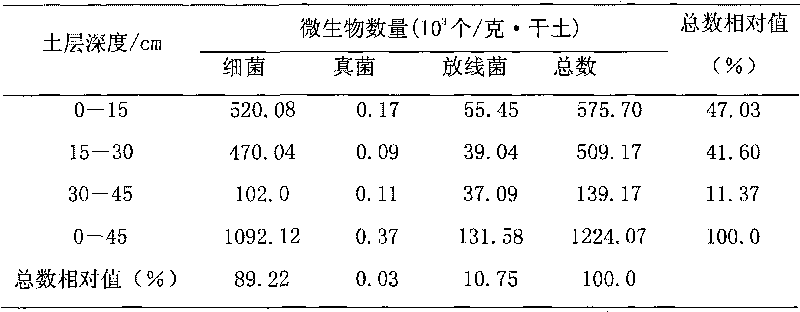Method for controlling wheat take-all in newly-reclaimed farmland
A technology for wheat take-all and farmland, applied in botany equipment and methods, horticulture, applications, etc., can solve the problems of small number and types of microorganisms, no very effective control methods, and difficulties in prevention and control work, and achieve rich microbial communities , Enhanced disease resistance, strong antibacterial effect
- Summary
- Abstract
- Description
- Claims
- Application Information
AI Technical Summary
Problems solved by technology
Method used
Image
Examples
Embodiment 1
[0015] Evaluation of Soil Microflora of Newly Reclamated Farmland
[0016] 1. Materials and methods
[0017] 1.1 Selection of test site
[0018] The experimental field is arranged in Team 2, Weizha Village, Weizha Township, Huinong District, Shizuishan City, Ningxia. This test site is a newly reclaimed land with an area of 1043.7 (49×21.3) m 2 , the soil is highly saline and alkaline, the fertility is insufficient, and the drainage and irrigation conditions are more convenient.
[0019] 1.2 The composition of the main community structure of soil microorganisms in newly cultivated farmland
[0020] 1.2.1 Sampling time: September 10, 2002
[0021] 1.2.2 Sampling method
[0022] Soil samples were collected at five points, and the soil depths were 0-15cm, 15-30cm, and 30-45cm. The soil samples at the same level at different locations were mixed and sealed, and brought back to the laboratory for analysis and determination.
[0023] 1.2.3 Measurement content and method
[0...
Embodiment 2
[0039] Effects of different crop planting patterns on soil microbial diversity and occurrence of wheat take-all
[0040] 1. Materials and methods
[0041] 1.1 Test soil
[0042] The soil was taken from the newly reclaimed farmland of Team 2, Weizha Village, Weizha Township, Huinong District, Shizuishan City, Ningxia after planting crops.
[0043] 1.2 Experimental design
[0044] In 2003, the new reclamation test site selected in 2002 was divided into 7 plots on average, and 7 crops of wheat, flax, corn, garlic, rape, and broad bean were planted respectively, and the area of each plot was 128.45 (6.5×21.3) m 2 , normal management in the field; 128.45 (6.5×21.3) m2 experimental plots where wheat, corn, broad bean, oil sunflower, rapeseed, garlic, and flax were planted in 2003 2 Divide them into two parts, one half will continue to plant the same crops as last year, and the other half will plant wheat under normal management; in 2005, the plots (1 / 2 ) and then divided into ...
Embodiment 3
[0075] Example 3: Research on functional diversity of soil microbial communities in different crop planting patterns
[0076] 1. Materials and methods
[0077] 1.1 Test soil
[0078] The soil for the test was taken from the newly reclaimed land in Weizha Township, Huinong District, Shizuishan City, Ningxia. The soil samples were the soil of 19 experimental plots with different crop planting patterns. The types of crops are wheat, flax, corn, garlic, rapeseed, sunflower, broad bean.
[0079] 1.2 Sampling time and method
[0080] The sampling time was June 30, 2008. The five-point sampling method was adopted for the soil samples, and the depth of the sampling soil layer was 0-15 cm. The soil samples of the same layer at different sites were mixed, sealed and brought back to the laboratory. The soil samples were stored in a refrigerator at 4 °C. The Biolog method was Measure within 48 hours.
[0081] 1.3 Determination method
[0082] The Biolog-ECO microplate method was use...
PUM
| Property | Measurement | Unit |
|---|---|---|
| Diameter | aaaaa | aaaaa |
Abstract
Description
Claims
Application Information
 Login to View More
Login to View More - R&D
- Intellectual Property
- Life Sciences
- Materials
- Tech Scout
- Unparalleled Data Quality
- Higher Quality Content
- 60% Fewer Hallucinations
Browse by: Latest US Patents, China's latest patents, Technical Efficacy Thesaurus, Application Domain, Technology Topic, Popular Technical Reports.
© 2025 PatSnap. All rights reserved.Legal|Privacy policy|Modern Slavery Act Transparency Statement|Sitemap|About US| Contact US: help@patsnap.com



